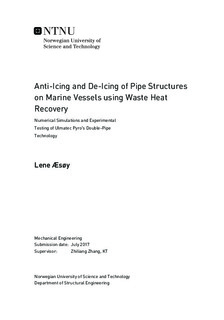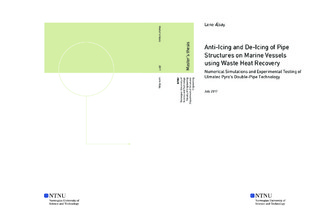| dc.description.abstract | Shipping, fishing and exploration activities in Arctic waters are endangered by ice accretion on critical structures causing various safety risks. Ulmatec Pyro have developed an anti-icing/de-icing system using waste heat circulation in a double pipe system , for hand railings, helicopter decks and stairway applications. The research objectives of this master thesis was to support Ulmatec Pyro in the design process, using theoretical models for design optimization, and to develop experimental facilities to verify their designs to meet the IMO Polar Code for ships operating in Arctic areas.
The first part of the project investigated relevant literature and research on icing mechanisms and de-icing technologies. Atmospheric icing is a known problem for mobile units such as airplanes. However, marine icing is more complex since it involves saline water. Further, the marine icing process is more unpredictable with a periodic behavior caused by the weather conditions.
Two different numerical models are developed, based on previous icing studies and combined with basic thermo- and fluid- dynamics. First, a simple 1-dimensional steady state anti-icing model was developed using finite difference method (FDM) and lumped capacitance method (LCM). This model programmed in MATLAB code, is made for a given symmetrical double pipe geometry, and shows good correlations with experimental tests. The second model is made in COMSOL Multiphysics, where 2-dimensional axisymmetric geometry is used. This model is able to handle transient as well as steady state conditions. The purpose of this model was to simulate de-icing processes. Comparing the steady state results, the CFD model and the simple 1D model shows good correlations. The transient de-icing simulations results give good results within the assumptions that the water is entrapped in the ice. However, the de-icing experiments show that this model must be modified to give more realistic ice-melting behavior. These modifications include water draining giving insulation air layers between ice and pipe surface, and further include saline ice models.
An experimental setup was designed and built for validating theoretical models, and further as a design verification lab for Ulmatec Pyro. The test lab was built inside a commercial freezing container, which turned out to have insufficient freezing capacity for the extreme Polar test conditions. Despite of these limitations, a series of experiments were conducted, providing valuable insight in the icing- and anti-icing processes. The experiments also showed that double pipes gave a more uniform surface temperature than a single pipe, and that it is favorable with a higher flow velocity in the annulus between the inner and outer pipe.
The experiments confirm that the double pipe technology is giving a more uniform surface temperature along the pipe compared to a single pipe. Hence, a more efficient use of waterborne heat. The experiments also provided good validation of the theoretical simulation models within the available test conditions. De-icing tests also showed the complexity of the ice melting process. Hence, it gave a better understanding of the de-icing process and that more complex simulation models are needed. The experiments also provided valuable experience and information needed to upgrade the test rig for further testing with more extreme Polar conditions. | |

